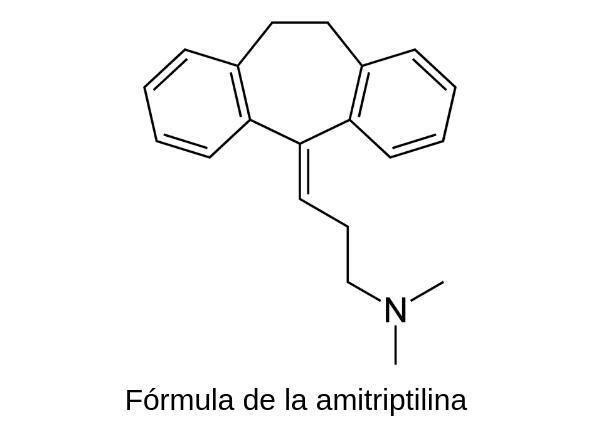
Antidepressants are part of the most common prescribed drugs in our country. Tricyclic antidepressants (TCAs) are named for their chemical structure, which includes as a base two rings joined by another central one, giving a three-dimensional structure. They are part of the cyclic antidepressants, made up of tricyclic antidepressants (three rings) and tetracyclic (four rings). ADTs are, together with monoamine oxidase inhibitors (MAOIs), the oldest antidepressants and continue to play a relevant role in current clinical practice, however they have been very limited.
If you are interested in knowing the ADTs, in this Psychology-Online article, we will explain the Tricyclic antidepressants: what they are for, names and side effects.
Index
- What are tricyclic antidepressants for?
- Choice of drug
- Tricyclic antidepressants: trade names
- Side effects of tricyclic antidepressants
What are tricyclic antidepressants for?
Tricyclic antidepressants are part of the group of antidepressant drugs and their effectiveness has been demonstrated in repeated investigations. The therapeutic effect of ADTs has been shown to produce a
Currently, it is debated whether ADTs have the most severe forms of depression, major depression, as their main indication. Even so, there are several disorders that are treated with tricyclic antidepressants with a specific indication for their use. The psychological disorders treated with tricyclic antidepressants are:
- Major depression
- Obsessive compulsive disorder (OCD)
- Panic attack with or without agoraphobia
- Generalized anxiety disorder
- Phobias
- Somatoform disorders and chronic pain, for example, in the case of fibromyalgia treatment
- Primary enuresis
Choice of drug.
How can we choose the right antidepressant? Even keeping in mind the specific indications of certain disorders that are treated with antidepressant drugs, specifically with ADT, it is difficult to select the most appropriate one, due to the large number of antidepressants available in the market. However, the side effects they produce drugs tend to be generally the main factor in drug choice. In addition, the variables of each drug must be adjusted to the variables of each patient profile. The variables that must be taken into account for the correspondence between the drug and the patient are the following:
Regarding the patient, it will be taken into account:
- Subtype of depression
- Age
- Gender
- Health condition
Regarding the drug, it will be taken into account:
- Side effects
- Safety
- Price
Tricyclic antidepressants: trade names.
ADTs are named based on their active ingredient, however, they all have a trade name. Next, the active principle, the commercial name, the therapeutic dose and the different forms of administration of each drug will be presented for each drug.
Active ingredient: Amitriptyline
- Trade name: Elavil
- Therapeutic dose (mg / day): 150-300
- Method of administration: tablets: 10, 25, 50, 75, 100 and 150 mg. or injectable: 10 mg / ml.
Active ingredient: Clomipramine
- Trade name: Anafranil
- Therapeutic dose (mg / day): 100-250
- Method of administration: capsules: 25, 50 and 75 mg.
Active ingredient: Desipramine
- Trade name: Norpramin
- Therapeutic dose (mg / day): 150-300
- Method of administration: tablets: 10, 25, 50, 75, 100 and 150 mg.
Active ingredient: Doxepin
- Trade name: Sinequan
- Therapeutic dose (mg / day): 150-300
- Method of administration: capsules: 25, 50, 75, 100 and 150 mg. or oral solution: 10mg / ml.
Active ingredient: Imipramine
- Trade name: Tofranil
- Therapeutic dose (mg / day): 150-300
- Method of administration: tablets: 10, 25 and 50 mg.
Active ingredient: Trimipramine maleate
- Trade name: Surmontil
- Therapeutic dose (mg / day): 150-300
- Method of administration: capsules: 25, 50 and 100 mg.
Active ingredient: Nortriptyline
- Trade name: Aventyl, Pamelor
- Therapeutic dose (mg / day): 50-150
- Method of administration: capsules: 10, 25, 50 and 75 mg. or oral solution: 10mg / 5ml.
Active ingredient: Imipramine Pamoate
- Trade name: Tofranil-PM
- Therapeutic dose (mg / day): 150-300
- Method of administration: capsules: 75, 100, 125 and 150 mg.
Active ingredient: Protriptyline
- Trade name: Vivactil
- Therapeutic dose (mg / day): 15-60
- Method of administration: tablets: 5 and 10 mg.

Side Effects of Tricyclic Antidepressants.
Today, ADTs are considered second or third choice drugs due to the difficulty in adjusting the interval. time in which said medication is administered and the determination of the dose to be given, as well as its toxicity implications. In addition, although tricyclic antidepressants generally have a lower price than other antidepressants, their benefit-cost ratio is not as good, because more visits tend to be necessary during treatment with this drug, more laboratory tests tend to be performed than normal and it is estimated that there is a greater intoxication due to overdose and a higher rate of interruption of its administration due to the side effects that generate.
The administration of ADT can lead to various side effects that can be grouped into four broad categories: anticholinergic, cardiovascular, central nervous system, and others. The side effects of tricyclic antidepressants are as follows:
1. Anticholinergic side effects
- Dry mouth
- Constipation
- Delayed onset of urination
- Esophageal reflux
- Confusion
- Difficulties for visual accommodation
2. Cardiovascular side effects
- Orthostatic hypotension
- Palpitations
- Hypertension
3. Side effects on the central nervous system
- Shaking
- Sedation
- Activation
- Myoclonic contractions
- Seizures
- Extrapyramidal symptoms
4. Other side effects
- Sweating
- Weight gain
- Sexual dysfunction, such as impotence and decreased libido
- Drowsiness
The most frequent being drowsiness, dry mouth, constipation and difficulty in accommodating vision. Notably alcohol consumption is contraindicated due to the strong potentiation of the drug that it entails.
In order to prevent side effects, it is very important to administer it slowly and progressively. In addition, some of the side effects can be alleviated by reducing the administered dose.
Tricyclic antidepressants overdose
In an overdose of ADTs, the person may have mental confusion, delusions, and loss of consciousness. In addition, overdose of these drugs can cause death, causing a reduction in heart rate and arrhythmias that can put a person's life in danger.
Tricyclic antidepressant treatment discontinuation
To make a correct withdrawal of the drug or to reduce its dose prudently, it should be done in a staggered way, reducing 25 or 50 mg each 2 or 3 days, to avoid rebound symptoms of anticholinergic side effects that can occur if withdrawn abruptly. The most common symptoms in abrupt withdrawal of tricyclic antidepressants are the following:
- Nausea and vomiting
- Gastrointestinal symptoms and an upset stomach
- Colic
- Sweating
- Headache
- Pain in the neck
Therefore, it is very important not to commit mistakes when taking antidepressants.
This article is merely informative, in Psychology-Online we do not have the power to make a diagnosis or recommend a treatment. We invite you to go to a psychologist to treat your particular case.
If you want to read more articles similar to Tricyclic antidepressants: what they are for, names and side effects, we recommend that you enter our category of Psychopharmaceuticals.
Bibliography
- Fe Bravo, M. (2002). Psychopharmacology for psychologists. Madrid: Synthesis.
- Schatzberg, A., Cole, J & DeBattista, C. (2005). Manual of clinical psychopharmacology. Barcelona: ArsMedica.
- Stahl, S. (2002). Essential Psychopharmacology: Neuroscientific Basis and Clinical Applications. Barcelona: Ariel Neuroscience.


